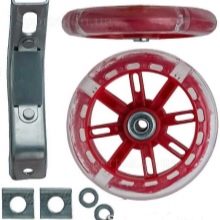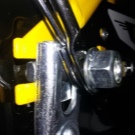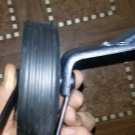Additional wheels for a child's bike: features, selection and installation

For every caring parent, the most important thing is the health and safety of the child. This issue becomes especially relevant at a time when the baby is already more independent and active. It is at this time that the child gets on his first bike, and adults definitely need to worry about buying additional wheels for such transport. In this article, you will find all the information you need to know on how to select and install them correctly.
Functionality and purpose
Safety wheels, which are also called additional wheels, are an integral part of a child's bike if the child is just learning to ride. This attribute performs the following functions:
- maintains balance;
- prevents the bike from falling over;
- protects the child from falls and possible injury.
The main thing is that the child, riding a bicycle with installed additional devices, feels safety and confidence.

Speaking about their advantages, I would like to note the following factors:
- there is no need to constantly be near the child when he rolls, and to hold him;
- the presence of this attribute enables the child to ride on almost any surface;
- even at a sharp turn, the bike will not fall;
- riding a bike with side wheels will prepare the child for future movement, but already on a two-wheeled vehicle.
And also it should be noted that riding an "iron horse" with such insurance has a good effect on the mood and health of the baby, first of all on the posture, coordination improves, the vestibular apparatus develops.


Varieties
There is a wide selection and assortment of additional wheels for a child's bike on the modern market. There are many different classifications, which are subdivided into different categories.
- Base material. Plastic and metal are used for the production of wheels for children's bicycles. They can be solid or knitted. The metal gear is attached with a bearing or bolt, the presence of which creates a high level of noise when driving.


- Coating material. It can be different. Today, they use silicone, rubber, plastic and PVC coating. All these materials differ in functionality and characteristics. It should be noted that the highest quality, durable and reliable is the silicone coating.



- Rack type. This is a very important element of the entire structure of the side attribute, because it carries most of the load, so it must be as stable as possible. Racks can be of several types.
- Tough. It is installed on bicycles with wheel diameters of 12, 14, 16, 20 inches.
- Universal tough. They fit absolutely all wheel sizes. So sturdy, comfortable, durable and reliable.
- Foldable. According to users, this does not justify the hopes and financial investments.
When choosing a rack, you need to take into account its length and the presence of an emphasis on the bend - it makes the product more durable and resistant to load.



- Wheel diameter. This characteristic is of great importance. From the production line of manufacturing plants, products come out, the diameter of which can be different. You can get acquainted with the information on sizes in detail by looking at the table:
Diameter, inches | Size in centimeters |
12´ | 13.5 cm |
14´ | 18 cm |
16´ | 20.3 cm |
18´ | 23 cm |
20´ | 25.5 cm |

How to choose
When choosing side gears for a children's bike, you need to be very careful, take into account many factors that affect not only the comfort of using the bike, but also the safety of the child. Should be considered:
- the diameter of the main bicycle wheels;
- the number of speeds on the bike;
- material of manufacture;
- coating;
- wheel shape;
- rack (bracket) size.


Earlier in the article, we described in detail each of the selection criteria and the classification of the additional structure. It is this information and data that should be guided by when choosing additional wheels for a children's bike.
How to install
After you have familiarized yourself with all the information and technical characteristics about this attribute, and even bought it, there is only one thing left - to install.
The process of installing additional wheels is quite simple and does not require a lot of time. Installation consists of several stages.
- Place the bike in a position with the main wheels on top.
- Using a special wrench of suitable size, you need to unscrew the rear wheel - unscrew the fixing nuts.
- Next, install the bracket and secure it with bolts and nuts. When installing the bracket, it is not necessary to immediately tighten the fixing elements to the stop. First flip the bike over to the correct position and make sure the side wheels are correctly positioned above ground level.
- If everything is done correctly and the distances are in accordance with the norms and requirements, you can firmly fix the wheels.






When the optional attribute is installed, carefully inspect the tension chain.
This is to ensure that it does not loosen during installation. If this happens, you just need to tighten it.
Now that the extra safety wheels are installed, you don't have to worry about the safety of your little cyclist! Although it will not be superfluous to purchase additional ammunition: a helmet and knee pads.
How to install side (additional) wheels on a child's bike is described in the video below.








